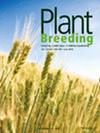通过硅学和 RT-PCR 方法预测和验证水稻(Oryza sativa)耐旱 QTL 潜在候选基因
IF 1.8
4区 农林科学
Q2 AGRONOMY
引用次数: 0
摘要
本研究的目的是利用硅学方法和实时聚合酶链式反应(RT-PCR)预测和验证水稻作物耐旱数量性状位点(QTL)的潜在候选基因。通过数据挖掘、序列变异、基因本体分析、数量性状基因查找器和基因表达分析等方法,对已报道的主要耐旱 QTLs 的基础基因进行了 RiceVarmap 软件设计引物,只有少数变体给出了 SNP/InDel 引物;因此,最终选择了 15 个引物,通过在水稻圆锥花序萌发期进行干旱胁迫处理,利用定量 RT-PCR 研究鉴定了 IR 64 和 N 22 这两个对比水稻基因型的抗旱性差异表达基因(DEGs)。在这项研究中,我们预测了 11 个基因作为耐旱 QTL 的候选基因。其中,只有四个 QTLs 对耐旱区域的主要影响负责,如 QTL-Qsn-4b、QTL-rn7a、QTL-Qtgw-2a 和 QTL-phc4.1,并确定了 11 个在叶组织中表达的优先候选基因。只有四个引物属于两个 QTL,分别是 QTL-rn7a 的引物 vg0712623096(LOC_Os07g22450)和 vg0431750843(LOC_Os04g53310),前者编码含 NAC 结构域的蛋白,后者编码可溶性淀粉合成酶 3-叶绿体前体、vg0432626757 (LOC_Os04g54850) 编码含果胶乙酸酯酶结构域蛋白和 vg0433031562 (LOC_Os04g55520) 编码含 AP2 结构域蛋白,这些引物来自位于染色体 4 上的 QTL-Qsn-4b,根据定量 RT-PCR 2-ΔΔCt 值,在干旱胁迫期间,N 22 与 IR 64 相比有更高的差异表达。从整个研究来看,这四个引物/基因被确定为影响耐旱性基因组区域的候选基因。因此,可重点对这些候选基因进行进一步的功能分析,以便在水稻育种中加以利用。本文章由计算机程序翻译,如有差异,请以英文原文为准。
Prediction and validation of putative candidate genes underlying drought‐tolerant QTLs through in silico and RT‐PCR approaches in rice (Oryza sativa)
In the present study, the aim was to predict and validate putative candidate genes underlying drought‐tolerant quantitative trait loci (QTLs) in rice crop using in silico approaches and real‐time polymerase chain reaction (RT‐PCR). The genes underlying major drought‐tolerant QTLs which have been reported by data mining, sequence variation, gene ontology analysis, quantitative traits gene finder and gene expression analysis were subjected to RiceVarmap software to design primers, and only a few variants gave the SNP/InDel primers; thus, finally, 15 primers were ultimately selected, which were used in identification of differentially expressed genes (DEGs) among contrasting rice genotypes IR 64 and N 22 for drought tolerance trait using quantitative RT‐PCR studies by providing drought stress treatment during panicle initiation stage. In this investigation, we predicted 11 genes as candidate genes underlying drought‐tolerant QTLs. Out of these, only four QTLs were found responsible for the major effect in drought tolerance regions such as QTL‐Qsn‐4b, QTL‐rn7a, QTL‐Qtgw‐2a and QTL‐phc4.1 and 11 prioritized candidates were identified that expressed in leaf tissues. Only four primers belong to two QTLs, primer vg0712623096 from QTL‐rn7a (LOC_Os07g22450) located on chromosome‐7 encoding NAC domain‐containing protein and the primers vg0431750843(LOC_Os04g53310) encoding soluble starch synthase 3‐ chloroplast precursor, vg0432626757 (LOC_Os04g54850) encoding pectin acetylesterase domain‐containing protein and vg0433031562 (LOC_Os04g55520) encoding AP2 domain‐containing protein, from QTL‐Qsn‐4b, located on chromosome‐4 found to have higher differential expression in N 22 in comparison with IR 64 during drought stress as per quantitative RT‐PCR 2–ΔΔCt values. Considering the overall study, these four primers/genes were identified as candidate genes underlying genomic regions governing drought tolerance. Therefore, these putative candidate genes could be focussed for further functional analysis to exploit in rice breeding.
求助全文
通过发布文献求助,成功后即可免费获取论文全文。
去求助
来源期刊

Plant Breeding
农林科学-农艺学
CiteScore
4.40
自引率
5.00%
发文量
74
审稿时长
3.0 months
期刊介绍:
PLANT BREEDING publishes full-length original manuscripts and review articles on all aspects of plant improvement, breeding methodologies, and genetics to include qualitative and quantitative inheritance and genomics of major crop species. PLANT BREEDING provides readers with cutting-edge information on use of molecular techniques and genomics as they relate to improving gain from selection. Since its subject matter embraces all aspects of crop improvement, its content is sought after by both industry and academia. Fields of interest: Genetics of cultivated plants as well as research in practical plant breeding.
 求助内容:
求助内容: 应助结果提醒方式:
应助结果提醒方式:


